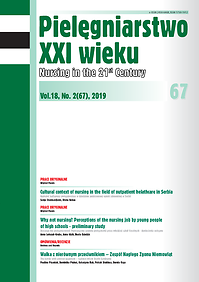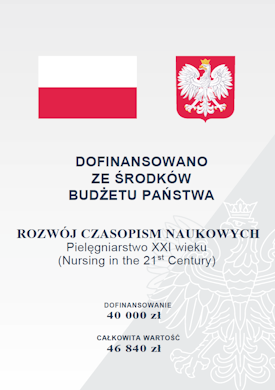The battle with uneven opponent – Sudden Infant Death Syndrome
DOI:
https://doi.org/10.2478/pielxxiw-2019-0013Keywords:
SIDS-Sudden Infant Death Syndrome, risk factors, sudden infant death, pathogenesis, preventionAbstract
THE BATTLE WITH UNEVEN OPPONENT – SUDDEN INFANT DEATH SYNDROME
SIDS is one of the biggest problems of modern medicine. In the diagnosis of SIDS, we take into account all possible diseases that may be the cause of death, as well as factors indicating an accident or murder. The etiology of SIDS is not yet known. There are several pathogenetic concepts, most of which refer to pathophysiological changes associated with nervous system hypoplasia. The most important risk factors include the effects of tobacco smoke, obstetric history, and incorrect sleep position. The role of risk factors in the pathogenesis of SIDS and their interdependence is still the subject of many studies. There are many theories developed on this subject, but none have been supported by scientific research and which is extremely difficult to carry out in this group of newborns. In most cases, medical help finds a newborn already dead, so it is difficult to say what is the main cause or marker of cot death.
A considerable success in preventing the onset of sudden infant death syndrome turned out to be educational campaigns for parents - in order to follow up, an information leaflet was prepared with the basic recommendations in the prevention of SIDS. Among the parents of newborn children there are still many controversial opinions about risk factors in the onset of sudden infant death syndrome, the article contains and explains the meaning of individual activities that are considered to predispose to SIDS.
References
1. Sarnecki J. Zapobieganie SIDS – zalecenia AAP. Stand Med. [Available online]: http://www.standardy.pl/newsy/id/141 (accessed on 02.05.2019).
2. Stanisław P. Ocena częstości występowania czynników ryzyka zespołu nagłej śmierci niemowlęcia, Rozprawa doktorska, Poznań 2010.
3. Lancien M, OdiliaInocente C, Dauvilliers Y et al. Low cerebrospinal fluid hypocretin levels during sudden infant death syndrome (SIDS) risk period. Sleep Med. 2017; (33): 57-60.
4. Horne R. Sudden infant death syndrome: current perspectives. Intern Med J. 2019; (49): 433-438.
5. Grygalewicz J. SIDS w nowym stuleciu. Zawsze ten sam?. Pediatr Pol. 2011;86 (2): 117-122.
6. Paula A, Farrell M, Gary M et al. SIDS, ALTE, bezdech i stosowanie domowych monitorów, Pediatria po Dyplomie. 2002; (3): 28-34.
7. Biet M, Ton AT, Delabre JF et al. In utero exposure to nicotine abolishes the postnatal response of the cardiac sodium current to isoproterenol in newborn rabbit atrium. Heart Rhythm. 2019; (4): 494-501.
8. Tomala L. Badacze na tropach przyczyn nagłej śmierci łóżeczkowej, [Available online]: http://naukawpolsce.pap.pl/aktualnosci/news%2C403108%2Cbadaczena-tropach-przyczyn-naglej-smierci-lozeczkowej.html. (accessed on 02.05.2019).
9. Buchanan GF. Impaired CO2-Induced Arousal in SIDS and SUDEP. Trends Neurosci. 2019;42(4):242-250.
10. Wcześniaki są bardziej zagrożone wystąpieniem SIDS. Nauka w Polsce. [Available online]: http://naukawpolsce.pap.pl/aktualnosci/news%2C414847%2Cwczesniakisa-bardziej-zagrozone-wystapieniem-sids.html. (accessed on 05.07.2017).
11. Sawiec P. Zapobieganie nagłym zgonom niemowląt. Aktualne (2016) zalecenia ,,American Academy of Pediatrics”. [Available online]: https://www.mp.pl/pediatria/artykuly-wytyczne/wytyczne/163740,zapobieganie-naglym-zgonomniemowlat. (accessed on 02.05.2019).
12. Kleszczyński J. Stany nagłe u dzieci. Warszawa: wyd. PZWL; 2017.
Published
Issue
Section
License
Copyright (c) 2019 Authors

This work is licensed under a Creative Commons Attribution-NonCommercial-NoDerivatives 3.0 Unported License.




